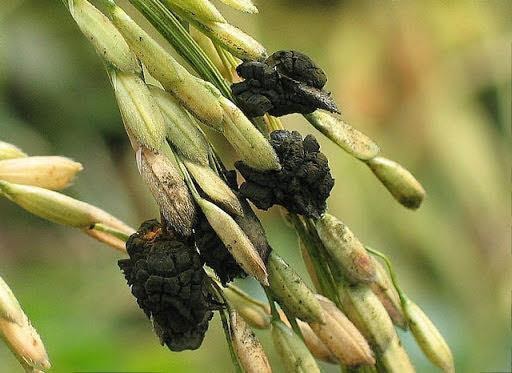Management of economic rice diseases

Disease damage to rice can greatly reduce yield. They are mainly caused by bacteria, viruses, or fungi. Planting a resistant variety is the simplest and, often, the most cost-effective management for diseases. Farmers lose an estimated average of 37% of their rice crop to pests and diseases every year. In addition to good crop management, timely and accurate diagnosis can significantly reduce losses. There is about 14.1% of Global crop yield losses from Pathogens , diseases causing loss equivalent to $220 billion USD.
Some of the economic rice duseases and their management are shown below:
Rice false smut (RFS)
Introduction
Rice is the number one crop in terms of cultivated area, production and consumption. IN the context of world consumption, rice occupies more than 60% which clearly shows how the production of rice may affect the food consumption of the world. There are different types of diseases which affect the production of rice among the false smut, the most common disease.
False smut in rice was recorded previously as a minor disease of rice and considered it as a symbol of good harvest in old times. But recently RFS has become a major problem for many countries, more than 40 countries especially in rice producing countries of Asia.

What causes it
The causative pathogen of RFS is Ustilaginoidea virens . As the common name ,it is not a true fungus, it is an Ascomycete .
What it does
The causative agent doesn’t affect the whole plant; rather it infects the flowers and transforms the latter into RFS balls. The balls at first grow slowly covering the floral parts. The early balls are found smooth and covered with thin membrane and as the growth of pathogen intensifies, it bursts out forming orange then later yellowish or greenish-black.
Conditions favourable for the pathogens
- Presence of heavy rainfall and high humidity
- Temperature ranging from 25-35 degree Celsius
- Presence of soils with high nitrogen content
- Presence of wind for dissemination of the spores from plant to plant
- Flowering stage of the rice crop
- Soils with high nitrogen content also favours disease development. Wind can spread the fungal spores from plant to plant.
Symotoms
- Replacement of paddy grains by ball-shaped fungal mycelia, called false smut balls, is the only visible symptom.
- Grains of the panicle are transformed into yellowish or greenish-black smooth spore balls.
- Smooth yellow coloured membrane which bursts and later produces powdery dark green spores.
- Although the pathogen affects the rice at the time of panicle development the symptoms are seen only after flowering.
- Partial or complete substitute of kernels with spores masses.
Effects
The disease affects the early flowering stage of the rice crop when the ovary is destroyed. The second stage of infection occurs when the spikelet nearly reaches maturity. This reduces the yield as well as the seed germination and quality of seed.
Control measures
- Keep field bunds and irrigation channels clean.
- Keep the field clean of weeds and remove infected plant debris, panicles and seeds after harvest.
- Deep plough and solarisation of the field after harvest also help to reduce the carry-over.
- If possible, perform conservation tillage and continuous rice cropping.
- Reduce humidity levels through alternate wetting and drying (AWD)rather than permanently flooding the fields.
- Treat seeds at 52°C for 10min.
- A preventive spray with copper-based fungicides during panicle emergence (2.5 g per litre of water during panicle emergence might be effective for the control of false smut in rice.
- Propiconazole at 1.0 ml/litre at boot leaf and milky stages will be more useful to prevent the fungal infection.
- At tillering and preflowering stages, spray Hexaconazole @ 1ml/lit or Chlorothalonil 2g/lit.
Rice blast
Introduction
Rice blast was first identified on California rice in 1996. It is a key concern in combating global food insecurity given the disease is responsible for approximately 30% of rice production losses globally, the equivalent of feeding 60 million people. These losses increase the global rice price and reduce consumer welfare and food security.

What causes it
It is caused by a fungus Magnaporthe oryzae . It can affect all above ground parts of a rice plant: leaf, collar, node, neck, parts of panicle, and sometimes leaf sheath. It is the most common spore form of the fungus. Under favourable conditions, the fungus sporulates in the center of the lesions on susceptible cultivars.
Conditions favourable for disease
- High humidity, free moisture.
- Large day-night temperature difference that causes dew formation on leaves and overall cool temperature favours the development of disease.
- 63°F-73°F temperature at night.
- Optimum temperature for sporulation, spore germination is 77°F-80°F.
- Sporulation is more when humidity is more than 93%.
Symptoms
- Initial symptoms may be appearance of gray-green lesions or spots, with green borders.
- Old lesions are spindle or elliptical shaped and whitish grey centers and red to brownish borders.
- If an Infection at the junction of the leaf blade and sheath in brown is seen then it is the symptom of collar rot.
- Diseased nodes are brown or black.
- Infection just below the panicle usually at the neck node causes a neck rot or rotten neck blast.
Damages
- Stem nodes may be attacked as the plant approaches maturity, causing death of stem above the infection.
- Rice can have blast in all growing stages; however, leaf blast incidence tends to lessen as plants mature and develop resistance to disease.
- Damage seen on leaf, nodes and panicle base.
- At a later stage the leaf blast reduces the leaf area for grain fill which leads to reduction in yield.
- Leaf blast can kill the plant at tillering stage.
- It shows an effect on plant growth, grain yield, and grain quality.
Rice blast is an economically important disease and has received attention in all major rice growing countries because of its severe destruction. Several epiphytotic of the disease have been recorded in different parts of the world resulting in serious losses in yield. So, the control measures are below.
Control measures
- Use of resistance variety, concern with your nearby agricultural office for new variety.
- Flooding of fields , as drought conditions favours the condition for disease growth.
- Different cultural practices should be followed ie: use of non-infested seeds, destruction of residue of infested plants, avoid excess nitrogen etc.
- Water seeding should be done to reduce transmission from seed to seedlings.
- Silicon fertilizers ie calcium silicate can be used in silicon deficient soil. But as silicon is expensive, efficient use should be done. Alternate sources of silicon like straw of silicon rich genotypes of rice can be used but the straw should be free frol blast disease as fungus can survive in straw.
Bacterial leaf blight
Introduction
The disease was first seen in Kyushu, Japan in 1884-85. BB of rice has high epidemic potential which specially destroys high yielding cultivars and can make loss upto 75% in both temperate and tropical regions especially in Asia. It causes wilting of seedlings and yellowing and drying of leaves. The disease usually occurs during the early stage of planting from maximum tillering to panicle initiation.

What causes it
Xanthomonas oryzae pv. Oryzae causes bacterial blight (BB) of rice.
Conditions favourable for disease
- The disease favours temperature at 25-34°C and relative humidity upto 70%.
- Rainy season when wind and rain drop wounds crops.
- Wet areas where there is a possibility of flooding, as the bacteria can easily move to different plants through water.
- Over use of fertilizer is suitable for the development of disease.
- Area where there is presence of weeds and strubbles of infected plants.
- Use of trimming tools for transplanting and by handling during transplanting can also trigger new infection.
Symptoms
- During the seedling stage, the infection is seen as a tiny water-soaked spot at the margin of leaves.
- On leaf blades the infection begins at the margin as a water-soaked stripe.
- Resulting in the wavy margin and yellow leaf within a few days.
- The lesion can cover the whole blade and turn white and later greyish contaminated within various saprophytic fungi.
- Symptoms observed at the tillering stage.
- Seedling wilt can be observed in 1-3 weeks after transplanting.
- Leaf sheaths and clumps of more susceptible cultivars may be attacked.
- In older plants, the leaves become yellow and then die.
Damage:
Bacterial blight is one of the most serious diseases of rice. The earlier the disease occurs, the higher the yield loss. Yield loss due to bacterial blight can be as much as 70% when susceptible varieties are grown, in environments favourable to the disease. When plants are infected at the booting stage, bacterial blight does not affect yield but results in poor quality grains and a high proportion of broken kernels.
Control measures
- The most efficient way of controlling bacterial leaf blight can be planting resistant varieties.
- Use the proper amount of plant nutrients, especially nitrogen.
- Good drainage of fields.
- Keep the field clean, remove weeds and plough under rice stubbles, straw which can serve as host of bacteria.
- Seed treatment with bleaching powder (100g/ml) and zinc sulphate (2%) reduces bacterial blight.
- Allow the fallow field to dry to supress disease agents in the soil and plant residues blight.
- Application of streptocycline @ 0.6% for spray.
Foot rot
Introduction
Foot rot in rice is a seed borne fungal disease. “Bacterial foot rot,” was found in Japan in July 1977. It was characterized by a dark brown decay of the tillers. Neighbouring tillers of the same crown were invaded systemically, causing foot rot symptoms. A soft rot, with an unpleasant odor, developed in young tissues of infected tillers. The fungus infects plants through the roots or crowns. It then grows systematically within the plant.

What causes it
Fusarium moniliforme (conidial stage), Gibberella fujikuroi (perfect stage).
Symptoms
- The disease affects seedlings in the nursery. Seedlings appear whitish pale and weaker.
- In case of severe infection, tips of seedling show symptoms of wilting. Infected plants die in nursery or soon after transplantation.
- Infected plants appear tall and flower earlier. Early flowering is due to hormones like gibberellins.
- Some plants show symptoms of fungal infection at the collar region.
- Plants die in about 2-6 weeks after infection. In certain cases, plants show stunted growth due to mycotoxins like fusaric acid.
- Due to variations in symptoms, identification of diseased plants becomes difficult.
- Roots of plants also branch abundantly as compared to healthy one.
- Pinkish growth of fungus is also visible at the base of plants and within spilt nodes.
Control measures
- Resistance variety should be used.
- The seed must be collected from an area free from disease.
- The seeds should be stored under dry conditions.
- The irrigated water must not be allowed to go from an infected area to a healthy area.
- Seed treatment with fungicides like benlate or topsin.
- Treat the seeds with Thiram or Captan or Carbendazim at 2 g/kg.

